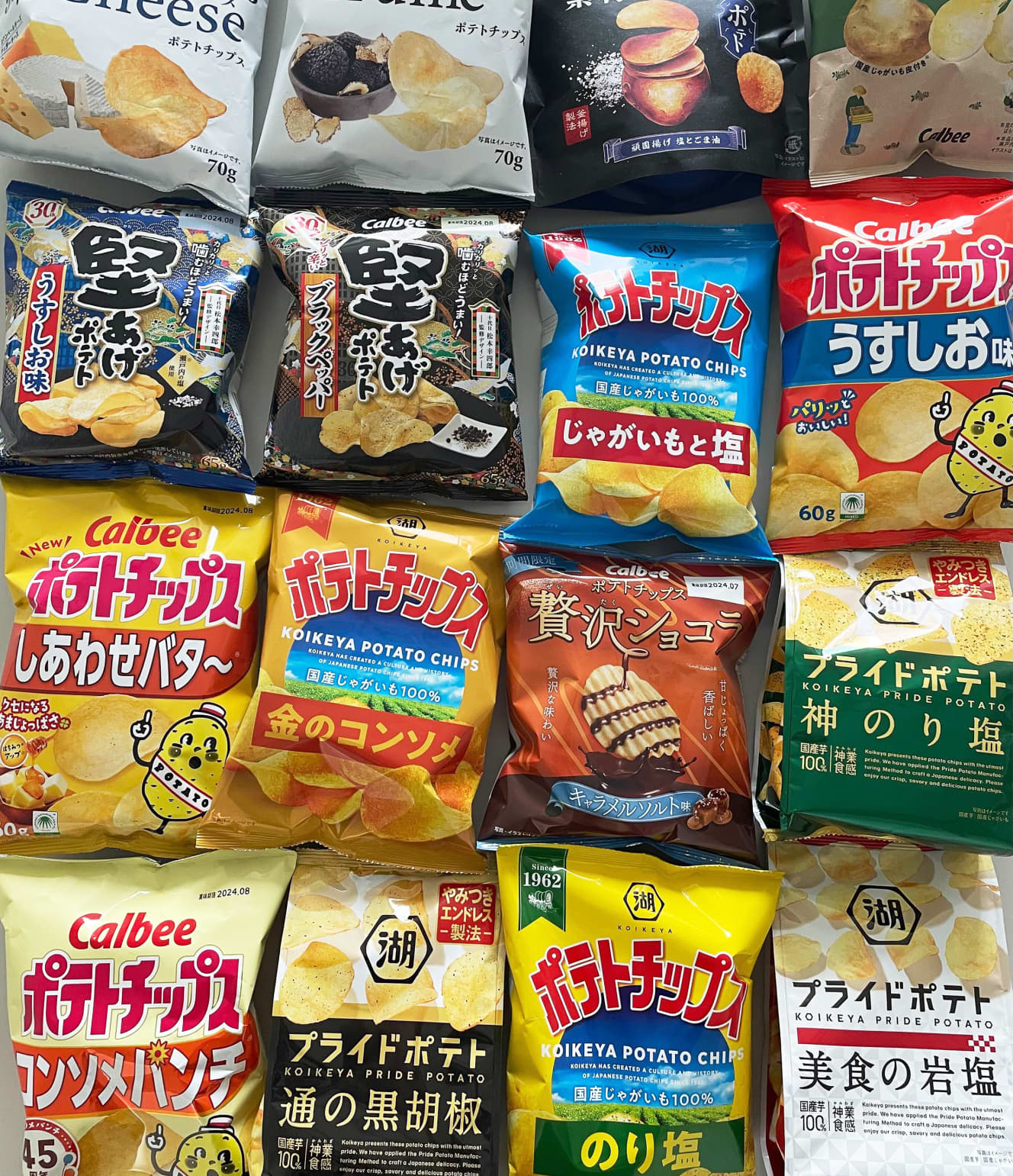Shohei Ohtani praised the best potato chips in his life! Calbee vs.
The absolute champion with "Calbee Potato Chips," "Kata-Age Potato," and "Pizza Potato" and the old champion with a diverse lineup from "Potato Chips Norishio" to "The Ingredient Treat" will battle it out!

Shohei Otani praised these potato chips as “the best potato chips of my life” and they are now available at Tokyo Station.
Gransta Tokyo” inside the Yaesu North Exit ticket gate. The product is lined up in a corner where ekiben and souvenirs are sold. When asked by a middle-aged male customer, “What is Otani’s favorite? The clerk pointed to the “Umami Dashi Flavor of Bonito and Kelp (993 yen)” in a familiar manner. The customer, a man in a suit who was probably going on a business trip, bought three of them.
The MLB reporter for a sports newspaper brought the chips as a gift to Otani, who is known for his love of sweets, and said they were the “best job he had ever done.
Potato chips account for more than 70% of all potato processed foods in Japan. While overall potato production declined by 30% from 1998 to 2009, consumption of potato chips increased by 30% during the same period. Potato chips will continue to be loved by Japanese people of all ages and both sexes as a national food.
Potato chips first appeared on the market about 60 years ago. Toyofumi Inada, a writer and author of “Potato Chips and the Japanese,” says, “The original Japanese potato chips were made in Japan.
The original Japanese potato chip was “Hula Mark American Potato Chip” by American Potato Chip Company, established in 1950. However, this product was not placed in confectionery shops, but was eaten by the wealthy as a snack served in some upscale bars and hotels. It was confectioner Kazuo Koike, the founder of Koikeya, who was impressed by these Hula Mark potato chips. Mr. Koike thought, “Let’s make this a snack for children,” and launched “KOIKEYA Potato Chips Glue Salt” in 1962. The price was 150 yen, which was relatively expensive compared to the snacks of the time, but by distributing them through confectionery wholesalers, they became available to the general public and were an explosive hit.
Potato chips, which had been imported from the U.S., were crossed with the familiar flavor of nori (dried laver), and a small amount of chili pepper was used to give them a sharp taste. The Japanese potato chips created by KOIKEYA are still the company’s mainstay product.
Headquartered in Tokyo, KOIKEYA succeeded in mass-producing potato chips in 1967, but because it did not have a large distribution network, its products were mainly sold in the Kanto region. People in the industry at the time said that potato chips would never make it past the Hakone barrier. While this situation continued for about 10 years, a new star appeared in western Japan. It was Calbee, which was headquartered in Hiroshima.
Calbee had launched an unprecedented hit product, Kappa Ebisen, in 1964, and had acquired a nationwide distribution network. However, know-how in processing potatoes is crucial for the production of potato chips. So Calbee, which had lagged behind Koikeya, was unable to enter the potato chip market.’ In 1972, Calbee launched Sapporo Potato, named after the Sapporo Olympics held that year, as a sister product to Kappa Ebisen. With the development of this product, which used flour and potatoes, Calbee acquired know-how in purchasing and processing potatoes. Three years later, in 1975, Calbee Potato Chips Usu-Shio Flavor was launched.
The Birth of the Calbee Empire
Usu-Shio” sold so well that Calbee soon became the number one seller of potato chips in Japan, but at that point, the gap between Calbee and KOIKEYA was minimal. The “Consomme Punch” was the second engine of the rocket that propelled Calbee to the top. The third president of Calbee, Mr. Matsuo, was the first to take the company to the next level.
Masahiko Matsuo, the third president, came up with the idea after drinking consommé soup. His commitment is so great that he makes consommé soup from scratch, turns it into powder, and sprinkles it on top of the powder to manufacture the product. No other company, a latecomer to the market, would make it from soup. …… Another feature is the use of ume plum powder to give it a crisp aftertaste. We created a hit by blending the Japanese and Western flavors of the delicious taste of consommé and the sourness of ume.”
Calbee’s momentum has not stopped.’ In 1992, they created Pizza Potatoes, another long-selling product.
In 1992, Calbee created “Pizza Potato,” another long-selling product. “We developed the ‘melted flake method,’ which reproduces the taste of pizza by melting cheese onto potato chips. Calbee’s technological expertise is packed into this product.
Calbee’s distribution network, its connoisseurship of potatoes, and its product development capabilities have all been brought together to create what is now Calbee. By combining all of these strengths, Calbee now enjoys a tremendous market share of 70% of the total market.
On the other hand, although KOIKEYA created the big hit “Karamucho,” the most popular type of potato chip was more of a stick type. The company was unable to come up with a new hit potato chip product, and the founder passed away in ’09. From ’12 to ’13, the company continued to suffer, recording losses for two consecutive fiscal years.’ From ’14 to ’15, the company went into a tailspin, introducing “mandarin orange” and “peach” flavors.
The current chairman, Takashi Koike, saw the need to fundamentally change the company, and in ’16 appointed Akira Sato, former president of Kirin Beverage, as the new president. Mr. Sato was an accomplished man who had made Kirin’s canned coffee “FIRE” and “Nama-tea” a hit. As soon as he assumed the position, he stopped the development of “milk-flavored” and other strange products, and presented his vision of “KOIKEYA with chefs” that would bring out the best of the ingredients through cooking. The first to take the lead was “Pride Potato,” launched in 2005. This product was made with the highest quality ingredients and a premium feel. Flavors such as “Matsutake Mushroom Scented Gokumi Dashi Salt” were also added to give the product a luxurious feel. We adopted a freestanding package so that the product can be placed on a desk in the office and eaten, and put a picture of a craftsman on the back to create the image of ‘Japanese cuisine'” (Inada, above).
The Pride Potatoes were a big hit from the first year and have become established as one of KOIKEYA’s most popular brands. Since then, “Pure Potato,” which was relaunched in 2006, and “The Ingredient’s Treat” (launched in 2011) have continued to do well, attracting attention.
Calbee employees must have been thinking, “They got us! “Calbee employees must have thought, ‘We’ve been hit! Because Calbee is particular about the quality of its ingredients, and its technology is the best in the industry. They just didn’t push it to the forefront. However, today, the image of ‘popular and familiar Calbee’ and ‘artisanal and quality-oriented KOIKEYA’ has permeated the market. I was impressed by President Sato’s skill.
Calbee, which had struck back at its supposedly leading rival, followed Kochiya’s lead and entered the high-end market with “The Potato” in 1919 and “Kraft Calbee Potato Chips” in 2009, but in this battlefield, Kochiya had the edge.
‘I think the next trend will be salt-free potato chips, backed by health-conscious consumers.’ Koikeya, which created a sensation in 2008 with its Pride Potatoes – Whole Potatoes, Salt Free, is expected to lead the boom.
An old powerhouse that had temporarily lost sight of itself in the face of an overwhelming champion, under the banner of an innovative leader, will usher in a new era with new tactics. It is a dramatic turn of events, almost like something out of a comic book. The supreme Calbee and the ultimate KOIKEYA. The second summit battle in the potato chip industry continues.





From the March 15, 2024 issue of FRIDAY
PHOTO: AFLO Kyodo News Agency Sankei Shimbun
